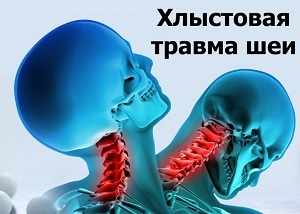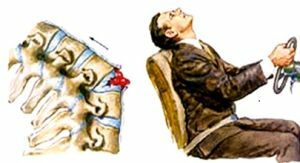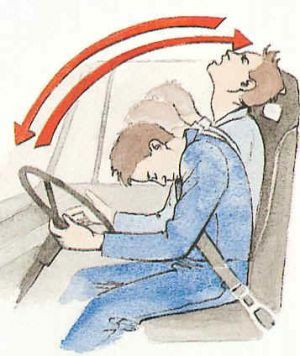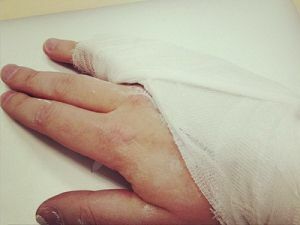 Whiplash injury is a damage to the ligaments and intervertebral neck joints. Most often, trauma occurs due to a strong, sharp bending of the neck forward and rapid extension of it in the opposite direction.
Whiplash injury is a damage to the ligaments and intervertebral neck joints. Most often, trauma occurs due to a strong, sharp bending of the neck forward and rapid extension of it in the opposite direction.
Hence the name of the diagnosis - whip( whip-like), because at the time of injury, the neck performs a movement similar to the stroke of a whip. The name of the diagnosis was given by the American doctor N.Srowe in 1928.
Contents of the article
- Reasons for injury
- Characteristics of injury
- Approach to diagnosis
- What is the essence of therapy?
- Folk methods
- Hazardous consequences and complications
- Forecast
- Rehabilitation
- Preventative measures
Reasons for injury
Whiplash injury of ligaments and intervertebral joints is a common trauma.
It can be obtained in situations such as:
- car accident;
- playing sports;
- at sudden drop;
- with a sharp impact;
- when diving into the water.
Most often, such a trauma is given to drivers and passengers of cars in an accident.
In this case, injury does not depend on the severity of the accident and is less common in frontal and side collisions.
As a rule, the whiplash injury of the cervical spine is acquired as a result of a blow to the car from behind by another vehicle or with sudden, severe braking. 
It happens this way:
- when striking the neck is very strained;
- there is a sharp movement of the cervical region forward;
- by the force of inertia, the upper body returns to its original position, ending with a sharp tilt of the head back.
It is noticed that such a trauma can be obtained by a passenger sitting anywhere on the car, in addition, people who are fastened with seat belts are more often exposed to her, since the belts hold the body of the body, but not the neck.
Every year in Russia, more than 3 million people get a whiplash injury. Among the diagnosed, women are 2 times more than men, which can be explained by the weakness of the neck muscles compared to the strong half of humanity.
Characteristics of injury
Depending on the nature of the injury, it can be mild or severe and have various symptoms:
- Light whiplash injury. If the stroke was insignificant, a person may not feel any symptoms of damage to the cervical spine. Only after a few hours, and sometimes even days, there are pains in the neck, neuralgic manifestations such as dizziness, nausea, numbness of fingertips. These symptoms can be so insignificant that the patient manages to take painkillers and does not consult a doctor, and after a while signs of trauma do not bother him at all.
- Heavy whiplash injury. Symptoms of severe damage appear instantaneously. A person feels a strong, sharp pain in the neck, lower back, thoracic spine. The general picture is aggravated by dizziness, visual impairment, nausea and vomiting. The danger of severe trauma is that the traumatic energy absorbs tissue cells, increasing their metabolism, as a result of which the whole body functions are disrupted, and not only the injured area.
Approach to diagnosis
 Generally, whiplash injury is diagnosed much later than it was received.
Generally, whiplash injury is diagnosed much later than it was received.
This is due to the fact that there is no visible damage to the neck area when injuring, and symptoms may not appear in the post-traumatic period.
Severe dizziness and pain begin to disturb the patient 2-3 weeks after getting injured.
Diagnostics includes several studies:
- X-ray is an obligatory study determining the presence of spasm in the cervical muscle group;
- MRI and computed tomography - determine if there are ligament tears, cartilage damage, hemarthrosis is detected;
- electroneuromyography - the nerve roots are examined, the degree of their damage is determined.
What is the essence of therapy?
Treatment for whiplash injury involves conservative methods.
In rare, especially difficult cases, when there is a danger of squeezing the spinal cord or with open fractures of the spine, surgical intervention can be prescribed.
Treatment of the consequences of injury is directed to:
- elimination of pain syndrome;
- achievement of normal motor function in the cervical spine;
- restoration of work capacity;
- prevention of the onset of chronic diseases.
The treatment method includes the following measures:
- The first orthopedic aid - for fixing the neck in the fixed position it is necessary to secure it with a special orthopedic collar. Its wearing is of a preventive nature and should not last more than 3
 days.
days. - Medical treatment - anti-inflammatory non-steroid drugs are used whose action is aimed at stopping pain, reducing edema of the tissues, reducing the sensitivity of nerve endings. During the acute phase, narcotic analgesics, which reduce pain and inflammation, can be prescribed.
- LFK and manual therapy - exercise therapy strengthens the muscular frame of the neck, helps to develop a habit of correct postures that will not lead to overloading of the shoulder girdle and neck joints in the future. Manual therapy is possible only when there are no fractures.
- Psychotherapy - classes with a therapist are aimed at eliminating or preventing post-spleen syndrome, suggesting a patient confidence in his normal functioning and recovery, as well as teaching relaxation techniques that relieve tension in the muscles of the cervical region.
Folk methods
In solving problems arising in the treatment of whiplash injuries, sessions of osteopathy are effective.
The whole point is that such a trauma does not pass without a trace for the entire human body, after the pain symptoms are eliminated, various kinds of curvature of the spine, difficult mobility of the bones of the skull, displacement of the vertebrae are often revealed.
During the treatment sessions, osteopath physicians warm and stretch muscles, relieve spasms and tension, and gently move organs and tissues.
Hazardous consequences and complications
Whiplash injury can cause a number of severe consequences and complications.
 Lack of timely treatment can lead to fibrosis - a process that irreversibly leads to ossification of muscles and ligaments.
Lack of timely treatment can lead to fibrosis - a process that irreversibly leads to ossification of muscles and ligaments.
Violations in muscle ligaments affect all adjacent organs, which leads to unpredictable consequences.
Complications can occur in the form of problems in the work of the gastrointestinal tract, genitourinary tract, pain in the pelvic region, etc.
And when you go to a doctor, the treatment will be directed at eliminating focal problems, for example, digestive dysfunction, while the real cause of the complications will remain unidentified.
Forecast
According to statistics:
- 60% of victims forget about whiplash injury in the first six months;
- 32% - get rid of symptoms in the second year after injury;
- and only 8% develop a post-hysterectomy syndrome.
Most often the chronic form of the consequences is acquired after severe accidents of grade 3 or 4.They are manifested in the limitation of movements in the shoulder region, numbness of the hands, visual impairment.
Along with disorders of musculoskeletal functions, neurotic and mental disorders can occur.
Rehabilitation activities
Complete recovery after whiplash is performed in a complex of different procedures: 
- psychotherapy;
- medical gymnastics;
- swimming( no earlier than 3 months after injury);
- breathing exercises;
- physiotherapy.
Rehabilitation is under the supervision of a physician, who in due time changes the appointed procedures depending on their effectiveness.
Preventive measures
To prevent injury, you can include measures to prevent it. Of course, it is difficult to foresee the possibility of a collision, or a fall, or that someone can strike.
But, for example, if you have to constantly drive a car, you can learn to behave so that the consequences of a road accident are minimal:
- Be sure to wear seat belts , neglecting this rule can lead to serious craniocerebral injuries and even death.
- Check that the is correctly seated in the car seat - between the bottom of the steering wheel and the stomach, a fist should be placed, the upper edge of the head restraint should be at the middle of the occiput, and if you rest your back on the seat, your arms should be stretched out.
- Sit just straight , this will help to avoid not only the whiplash injury, but also fractures of the spine in case of a strong impact.
The consequences of whiplash injury are unpredictable. They can stand out in mild cases, but it is possible that the symptoms will remain with the victim for life.
Once trauma can lead to a cervical spine vulnerability for life and cause the development of other serious diseases, for example, arthrosis of the intervertebral joints.
Only qualitative diagnosis can reduce the risk of whiplash injury, therefore, do not neglect the examination, even if the symptoms are not too disturbing or absent at all.



